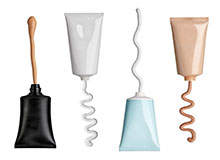

2014 has barely started, but packaging designers are already developing next year’s designs. But working so far in advance can be a challenge, particularly when it comes to predicting what packaging will appeal in 2015.

Discover B2B Marketing That Performs
Combine business intelligence and editorial excellence to reach engaged professionals across 36 leading media platforms.
Perceptions of the future change over time, but are always an effective way to engage with consumers. According to Global Color Research director of creative projects Laura Perryman, the future will be a major influence in packaging in 2015. However, this is not the heavy, industrial view of the future that we’ve seen previously, but a lighter, airier version that plays on the senses.
Perryman presented this trend, which she calls The Future’s Light, at the recent Packaging Innovations show in London. She describes it as "an imaginative mood inspired by a need to simplify our approach and outlook to materials, [which] sees visually tactile effects creating otherworldly qualities".
Aesthetically, this trend involves subtle colours and barely-there materials, giving a lightweight, ethereal feel to packaging. There will be a strong focus on engaging the senses, with the use of tactile elements and emerging material technologies such as 3D printing.
Material simplicity: uncluttered spaces

US Tariffs are shifting - will you react or anticipate?
Don’t let policy changes catch you off guard. Stay proactive with real-time data and expert analysis.
By GlobalDataInstead of focusing on bright colours and intricate details, the trend plays into a vision of the future involving light-filled, uncluttered spaces, creating simple, beautiful packaging.
"This trend speaks to a kind of new simplicity with materials," explains Perryman. "It’s more the tactile surface effects creating these qualities rather than so much being put into the colour, the surface, the form, so it’s about these really small changes in effect."
In particular, packaging should appear to (or perhaps even actually) radiate light. "Within the presentation I showed surfaces that radiate light, or have lenticular qualities to them," explains Perryman. "They hint, almost, at something new."
While providing an illusion of simplicity, the materials in this trend could in reality be quite complex, with complex properties such as the ability to react to light conditions. Perryman believes this could also have added benefits for packaging.
"You might have a plastic that has light-changing qualities about it, so say if it was on the shelf for a really long time it might well reflect, it might well protect the object underneath from the light so it might help lengthen the product [life]," she explains.
Engage the senses: tactile effects
Sensory involvement is very important in this trend; however the colours involved are light and subtle. "Barely-there tones or wisps of colour decorate, while white offers a permanent base," says Perryman.
Different finishes and tactile effects are used to engage consumers and make the packaging stand out. Perryman believes some of the best materials for this trend are plastic or glass and semitransparent materials such as frosted papers.
However, it is how the consumer interacts with these materials that is most important. Perryman explains: "It could be things like really thin plastics or plastic sheeting that maybe has a tactile finish so when you break it open it creates a sound or there’s this other sensory quality to it."
As there is an overwhelming sense of lightweightness within the trend, Perryman believes this could translate into superthin, one-use packaging. "It [is] all about the sensorial experience – packaging being enclosed in something that you would break open to get inside of," she says.
This approach could even translate into cleverly designed packaging that reacted to being opened. "Packaging that [is] hidden beneath a layer so when you opened it up, it released the object and almost pushed it through the surface," says Perryman.
Bespoke first: pearlescent qualities
At its heart, Perryman believes this a trend for bespoke and one-off packaging with limited runs, citing glass makers who manufacture sets of 200 or 50 bottles for a specific event. "I think this trend really speaks to that," she says. "This idea of the kind of very translucent or ethereal textures within the glass, creating intrigue, and the pearlescent qualities almost hint towards something that there’s not many made of."
In particular, she believes that the reflective, light qualities of the trend could make it very appropriate for food and beverage packaging for the luxury market. She explains: "This idea of the intriguing coatings or the new dimensions of the three dimensional packaging – you could be presenting the food in new ways through those forms."
However, this is not to say that the trend could not work for more mainstream packaging, with pearlescent finishes being an easy way to bring this style to larger, low-cost runs. "Those intriguing qualities will help products stand out on the shelf, so I think that it could be something that you could reference," says Perryman.
3D printed: infinite possibilities
For bespoke runs, Perryman believes 3D printing could play a role. "That could create infinite possibilities with the shape and form, because 3D printing allows for moulds and prototyping and tool making to be taken out of the equation when it comes to design of shape," she explains.
While the current cost of 3D printing limits itself for packaging, Perryman sees it becoming more of an option when the price comes down. "I was questioning whether it could fall into a packaging market, especially when it comes to bespoke projects, but there could be beautiful pieces that hold exquisite pieces of jewellery that are really one-off," she adds.
As 3D printers become more ubiquitous, the technology could even lead to consumers manufacturing their own packaging. "You could be designing your own packaging or your own holders for the products you own," says Perryman.
This trend is based on Aura, from Mix Trends issue 28, Spring Summer 2015. For more information on colour and materials trends or Mix Trends go to www.globalcolor.co.uk



